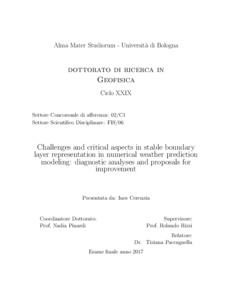Cerenzia, Ines
(2017)
Challenges and Critical Aspects in Stable Boundary Layer Representation in Numerical Weather Prediction Modeling: Diagnostic Analyses and Proposals for Improvement, [Dissertation thesis], Alma Mater Studiorum Università di Bologna.
Dottorato di ricerca in
Geofisica, 29 Ciclo. DOI 10.6092/unibo/amsdottorato/8067.
Documenti full-text disponibili:
![[img]](http://amsdottorato.unibo.it/8067/1.hassmallThumbnailVersion/tesi.pdf)  Anteprima |
|
Documento PDF (English)
- Richiede un lettore di PDF come Xpdf o Adobe Acrobat Reader
Disponibile con Licenza: Salvo eventuali più ampie autorizzazioni dell'autore, la tesi può essere liberamente consultata e può essere effettuato il salvataggio e la stampa di una copia per fini strettamente personali di studio, di ricerca e di insegnamento, con espresso divieto di qualunque utilizzo direttamente o indirettamente commerciale. Ogni altro diritto sul materiale è riservato.
Download (16MB)
| Anteprima
|
Abstract
This thesis explores the use of a lower limit to turbulent diffusivity (long-tail) in operational numerical weather prediction modelling. Its introduction in the 90's was advocated by a better simulation of the synoptic scale dynamics, but led to inaccurate representation of the scarcely diffusive stable boundary layer (SBL). After 20 years, a clear alternative to long-tail in operational forecast does not exist yet. This dissertation develops the hypothesis that the parametrization of processes occurring at the unresolved scale, and currently neglected, can increase the cross-isobaric flow as much as the long-tail formulations.
The topic is investigated by using a limited area model, COSMO, operational at several European weather services.
First, the turbulence and transfer schemes operational in COSMO are described. Then the applied long-tail formulations are described, their influence on SBL is investigated, alternative formulations are proposed in case their turbulence-enhancing effect is an undesired side effect and finally their influence on the operational transfer scheme is explored.
Finally, the potential role of two neglected subgrid scale processes, to overcome the operational long-tail need in SBL, is evaluated: i) the kinetic energy transfer from circulations induced by unresolved orography to turbulence, ii) the modification on the SBL structure induced by unresolved thermal heterogeneity of the surface.
Results show that the parametrization of the first process, already in COSMO, gives a more physical but still partial answer to the operational long tail need. The second process is described by the tile approach, whose behaviour in SBL has not been fully investigated yet. The approach is explored by idealized numerical experiments, also combining it with different order turbulence schemes. Results indicate that the tile method manages to represent, at least partially, the modifications induced by the thermal heterogeneous terrain and has the potential to produce a positive feedback on large scale dynamics.
Abstract
This thesis explores the use of a lower limit to turbulent diffusivity (long-tail) in operational numerical weather prediction modelling. Its introduction in the 90's was advocated by a better simulation of the synoptic scale dynamics, but led to inaccurate representation of the scarcely diffusive stable boundary layer (SBL). After 20 years, a clear alternative to long-tail in operational forecast does not exist yet. This dissertation develops the hypothesis that the parametrization of processes occurring at the unresolved scale, and currently neglected, can increase the cross-isobaric flow as much as the long-tail formulations.
The topic is investigated by using a limited area model, COSMO, operational at several European weather services.
First, the turbulence and transfer schemes operational in COSMO are described. Then the applied long-tail formulations are described, their influence on SBL is investigated, alternative formulations are proposed in case their turbulence-enhancing effect is an undesired side effect and finally their influence on the operational transfer scheme is explored.
Finally, the potential role of two neglected subgrid scale processes, to overcome the operational long-tail need in SBL, is evaluated: i) the kinetic energy transfer from circulations induced by unresolved orography to turbulence, ii) the modification on the SBL structure induced by unresolved thermal heterogeneity of the surface.
Results show that the parametrization of the first process, already in COSMO, gives a more physical but still partial answer to the operational long tail need. The second process is described by the tile approach, whose behaviour in SBL has not been fully investigated yet. The approach is explored by idealized numerical experiments, also combining it with different order turbulence schemes. Results indicate that the tile method manages to represent, at least partially, the modifications induced by the thermal heterogeneous terrain and has the potential to produce a positive feedback on large scale dynamics.
Tipologia del documento
Tesi di dottorato
Autore
Cerenzia, Ines
Supervisore
Dottorato di ricerca
Ciclo
29
Coordinatore
Settore disciplinare
Settore concorsuale
Parole chiave
Numerical Weather Preditiction model;
the COSMO model;
Stable boundary layer;
Parametrization;
turbulence scheme;
transfer scheme;
long-tail;
tile approach;
URN:NBN
DOI
10.6092/unibo/amsdottorato/8067
Data di discussione
22 Maggio 2017
URI
Altri metadati
Tipologia del documento
Tesi di dottorato
Autore
Cerenzia, Ines
Supervisore
Dottorato di ricerca
Ciclo
29
Coordinatore
Settore disciplinare
Settore concorsuale
Parole chiave
Numerical Weather Preditiction model;
the COSMO model;
Stable boundary layer;
Parametrization;
turbulence scheme;
transfer scheme;
long-tail;
tile approach;
URN:NBN
DOI
10.6092/unibo/amsdottorato/8067
Data di discussione
22 Maggio 2017
URI
Statistica sui download
Gestione del documento:


 Login
Login
